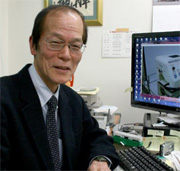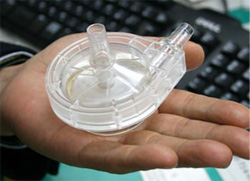Home > Highlighting JAPAN > Highlighting Japan FEBRUARY 2012 > New Ventricular Assist System Offers Continuous, Lightweight Support
Highlighting JAPAN
SCIENCE
New Ventricular Assist System Offers
Continuous, Lightweight Support
In 2011, a research group led by Professor Setsuo Takatani of the Tokyo Medical and Dental University together with professor Tadahiko Shinichi of the Tokyo Institute of Technology successfully developed an extremely inexpensive and highly durable ventricular assist system. Takashi Sasaki reports.

Professor Setsuo Takatani of the Institute of Biomaterials and Bioengineering at Tokyo Medical and Dental University
Credit: TAKASHI SASAKI
VAS's are divided into two types: intracorporeal and extracorporeal. Whether a pump is installed internally or externally depends on the disease state of the patient.
"We aim at commercializing an extracorporeal VAS that can be safely used for one week to one month. That will serve as a very effective bridge for those who are awaiting their chance at heart transplantation, those discussing optimal therapy and those who have to build up enough physical strength to withstand surgery and other therapies," says Professor Setsuo Takatani of the Institute of Biomaterials and Bioengineering at Tokyo Medical and Dental University. "The VAS also helps restore the heart itself as well as serving as a bridge. When the VAS assists the heart and lets it rest for a certain period of time, symptoms of the heart can typically be improved to the extent that surgical operations or therapies are no longer needed. This is because the human heart has an intrinsic self-healing power."
The VAS being developed by Professor Takatani's group is a continuous-flow type that continuously allows blood to flow without requiring inflow and outflow valves by rotating an impeller.

Pump head of the newly developed VAS
Credit: TAKASHI SASAKI
Conventional continuous-flow VAS's generate heat because of the friction between the impeller and the bearing, since the bearing supports the impeller. This frequently leads to destruction of blood cells and the formation of blood clots. For this reason, a pump section consisting of an impeller and a bearing needs to be replaced within twenty-four to forty-eight hours.
In contrast, the VAS developed by Professor Takatani's team essentially does not generate friction or heat since the impeller rotates without contact, which is also why it permits long, continuous use. The new VAS will probably be sold at a price as low as 1/10–1/20 that of currently commercially available VAS's because it has a simple structure consisting of an 8-cm-across pump head section including an impeller and a section including a magnet and a motor. With total weight as light as a few hundred grams, the system is easy to carry without placing much burden on the patient. Conventional VAS's require a large volume of blood to prime it, but Professor Takatani's group's new VAS can be attached to a child's body and used even without blood transfusion.
In a sixty-day test in calves, the new VAS successfully maintained blood circulation without replacement of the pump section, which was twice as long as the target period in research and development. During 2012, a clinical trial will be initiated in actual patients with heart disease.
Professor Takatani's research group has also already established a technology for the world' first magnet-free magnetically levitated VAS. This employs a so-called magnetic iron material instead of the permanent magnet that surrounds the impeller. Permanent magnets essentially require expensive rare earth metals, and realization of a magnet-free magnetically levitated pump will allow further cost reduction.
By magnetically levitating and rotating, a small impeller is about to assist those suffering from serious heart disease.
© 2009 Cabinet Office, Government of Japan






